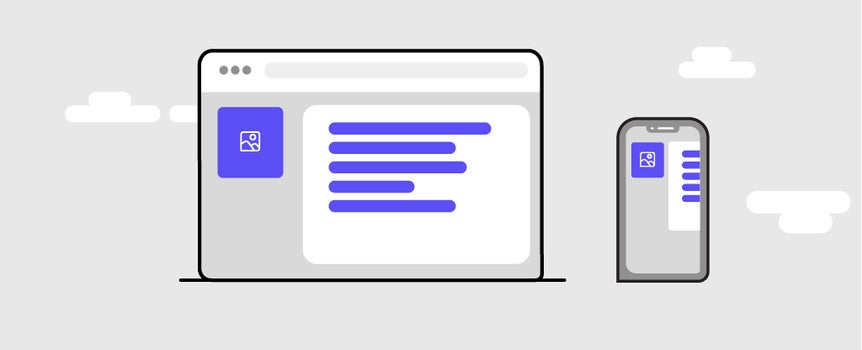Unlock business potential of APIs
APIs are usually a bad word among business people. It’s that technical jargon no one wants to hear about. We get it, but you'll earn a serious advantage if you know how they can serve you. In this lesson, you’ll uncover what an API is and how it can benefit you.
Take full control
As a content manager, understanding APIs is crucial, especially when working with a headless CMS. An API acts as a bridge between your content and the various platforms where it can be displayed. This knowledge empowers you to manage and distribute your content more effectively across different digital channels. With APIs, you can:- Ensure Consistency: Keep your content consistent across all platforms. Update once, and see the changes reflected everywhere.
- Expand Reach: Easily publish your content to new platforms, such as mobile apps, smart devices, and even IoT gadgets.
- Enhance Collaboration: Work seamlessly with developers and designers, as APIs allow for clear separation of content from design, facilitating teamwork.
- Automate Processes: Integrate with other tools and services to automate workflows, such as social media posting or email marketing campaigns.
- Gain Flexibility: Modify and repurpose content for different contexts without needing to access the back-end of each platform.
What’s an API?
API stands for application programming interfaces. Let’s go through the words and explain what they mean.Interface is like a socket or dictionary
When you plug your vacuum cleaner into the socket in the wall, you’re accessing electricity through its interface – the socket. So, the socket is the gate to the electricity network. It must have some compatible standards so that you can do it. The plug must fit the socket, and there must be electricity with specific properties. Similarly, when you travel to a different country where they speak a foreign language, a dictionary enables you to understand the menu in a restaurant. Again, the dictionary is the gate to another language. But you need to have a dictionary for that language. Otherwise, you still have a dictionary, but it’s incompatible. In the virtual world of computers, the interface is just a fancy word for the same thing. It’s a gate to something, be it some functionality or information. There are also more types of these gates, so you need to work with the correct one.Programming just means automatically
Imagine that instead of a vacuum cleaner, you have a robot vacuum cleaner. It accesses the electricity as it pleases and turns its charging on and off how it wants. It is automatic. Similarly, you can just point your phone to a restaurant menu, and most translation apps will translate it for you. Again, it looks up the words in the dictionary automatically. In the virtual worlds of computers, programming interfaces mean that these gates can be accessed automatically.Application is the location
For vacuum cleaners, it would be a socket interface. For dictionaries, it could be a language interface. Application interfaces are gates of an application. For example, Kontent.ai’s APIs are interfaces to the Kontent.ai application. When you use another software with APIs (for example, Salesforce, Hubspot, or DAM), you can just connect two interfaces, and both applications work together.How can an API benefit you?
Once you can connect (otherwise called integrate) two or more applications together, you have almost limitless connection options
Vendor lock-in
The risk of vendor lock-in in the monolithic CMS world is high because of how everything is tied together. These vendors don’t want you to leave or replace parts of their system. They provide everything in one black box, such as what content is displayed and how it looks, and it is against their product adoption metrics to let you use other services. If you don’t like something about your monolithic CMS’s front end, you’re in bad luck. The way out of this is good APIs, but since there’s no incentive for monolithic vendors, their APIs are often inadequate. Pay attention to the following lock-ins when picking a new CMS regarding APIs.Language lock-in
This article is in English, therefore you can understand it. It wouldn’t be so if we used our own language, unknown to others. It’s the same with APIs. The vendor should use a common data format for communication without unnecessary, unimportant information.Channel lock-in
Limited APIs limit your outreach. The CMS you’ve selected might have amazing support for the web channel, but it falls short elsewhere. We could go even further and say some CMSs hinder the use of content in other channels due to their clunky API. You won’t be able to get that one content item formatted well on a smartwatch if it’s designed to fit only on phones or monitors.
Information lock-in
A good API allows a seamless flow of your content anywhere, into any front end. The CMS shouldn’t dictate which content is accessible. Content consumers are the ones who dictate this. You are only able to cater to their needs if the API is good enough to allow for that.Interpretation lock-in
A good API reflects your content model. The API shouldn’t voluntarily interpret your content model because the model represents important semantic relationships. The API should be an enabler. It should enable the adaptation of your content model to push content anywhere.What good APIs can do
One important distinction between a good and bad API is what it allows you to do. A good API enables you to create, read, update, and delete (often abbreviated as CRUD) all of your content. Also, a good API covers all administration operations that you can perform in the CMS too. Such broad coverage allows for easy migrations, exports, and advanced integrations with other services.While monolithic vendors don’t need or even want APIs, headless vendors rely on APIs. Bad APIs mean accessing content is bad, thus making such a CMS bad by definition. It’s, therefore, in the best interest of headless vendors to provide the best APIs possible.